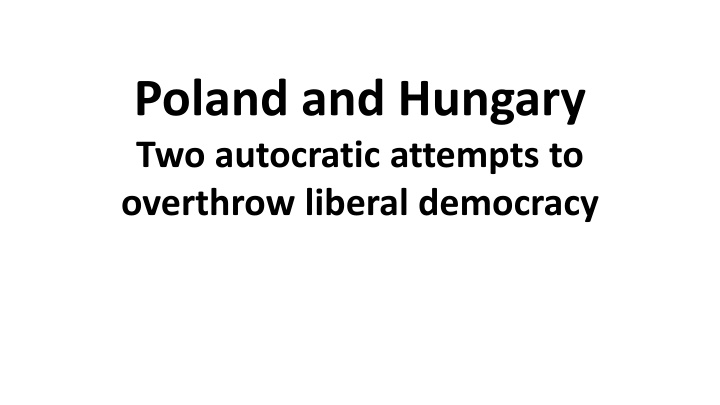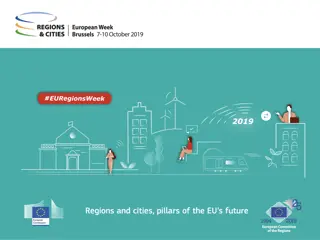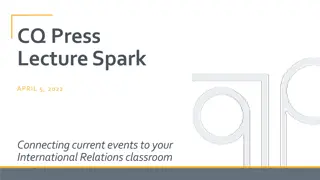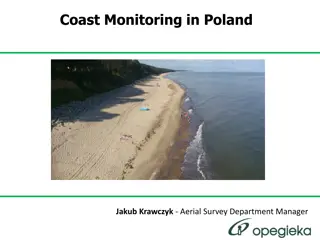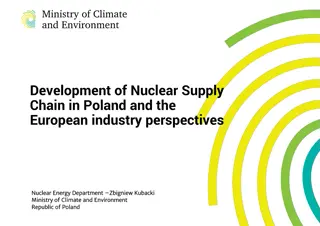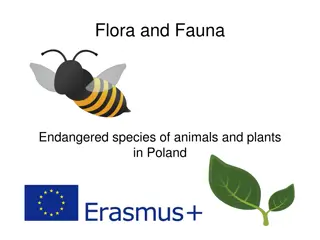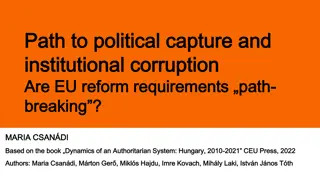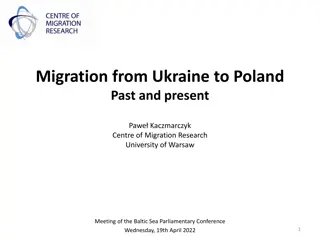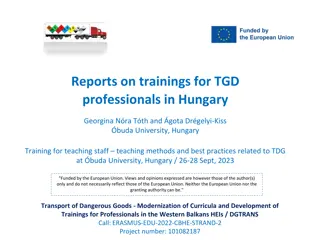Comparing Autocratic Attempts in Poland and Hungary
Poland and Hungary exhibit common ideological frames in their autocratic attempts, focusing on regime change rather than government shifts. These attempts utilize ethnonationalism, Euro-skepticism, and xenophobia to justify their actions. The two countries also showcase different types of post-communist autocracies, with Poland reflecting a conservative autocracy and Hungary embodying a post-communist mafia state driven by power and personal wealth.
Download Presentation

Please find below an Image/Link to download the presentation.
The content on the website is provided AS IS for your information and personal use only. It may not be sold, licensed, or shared on other websites without obtaining consent from the author.If you encounter any issues during the download, it is possible that the publisher has removed the file from their server.
You are allowed to download the files provided on this website for personal or commercial use, subject to the condition that they are used lawfully. All files are the property of their respective owners.
The content on the website is provided AS IS for your information and personal use only. It may not be sold, licensed, or shared on other websites without obtaining consent from the author.
E N D
Presentation Transcript
Poland and Hungary Two autocratic attempts to overthrow liberal democracy
Common ideological frames: the ostensible similarity of the Polish and Hungarian autocratic attempts (1) their governance is not defined as changes of government, but as changes of regime; accordingly, they distance themselves from the regime change of a quarter century ago, and interpret the history of the peaceful, negotiated change of regimes as the deal between elites concluded over the heads of society; and they attempt to use this to legitimize the necessity for the actual regime change they represent; they mean under nation a community of people committed to an ideology, rather than a community of autonomous citizens, by which means they seek to create a basis of legitimacy and an argument for excluding citizens critical of their regime from the nation, and paint them as representatives of alien interests; etnonationalism;
Common ideological frames: the ostensible similarity of the Polish and Hungarian autocratic attempts (2) they share a particular form of Euro-skepticism, and continue a national freedom fight against Brussel s dictatorship on the basis of a historicized grievance politics, while continuing to expect the EU resources; this behavior is no less than the realization of a rent-seeking policy on international scale, without moral qualms; fear and suspicion of refugees, migrants and aliens is exceptionally high in both countries, which populist politics easily transforms into active xenophobia. (hate campaign fear campaign) The similarities between these ideological frames only demonstrate that they are equally adaptable to the needs of different types of autocratic regimes.
Two types of post-communist autocracies (1) Poland s conservative autocracy Hungary s post-communist mafia state motivated by power and personal wealth; ideology applying: cynic and rational ; (amoral familism); political-economic decision-making is removed from the legally defined, formalized organizations and social control; informal body of leadership: chief patron s court; ruling party = transmission belt party; motivated by power and ideology; ideology driven: fanatic and emotional ; the actual decision-making remains centered within the framework of formal institutions; formal body of leadership: PiS leadership; ruling party = centralised party;
Two types of post-communist autocracies (2) Poland s conservative autocracy Hungary s post-communist mafia state state dirigist bureaucratic control; but respects the free market competition and the freedom of enterprise; party political nepotism; favouritism, but more or less combatting corruption; the loyal elit is maily rewarded with offices and not wealth; single pyramid patronal network; a centralized chain of command built on a patron-client network of vassalage; adopted political family; mafia state: centralizing and monopolizing corruption; the adopted political family accumulates wealth through the bloodless instruments of state coercion: rent-seeking and centrally led corporate raiding; criminal state (privatised form of a parasite state). authoritarian state.
International preferences in the two autocratic schemes (1) In Hungary Orb n In Poland Kaczy ski foreign policy = positioning Orb n; is not fighting Germany, he is fighting Merkel; (changing after leaving EPP) has ejected all politicians and diplomats committed to the Atlantic Alliance from his foreign affairs team; via the program of Eastern Opening foreign policy aims to secure socially unchecked, freely expendable resources for the adopted political family through its connections to Putin and other autocrats, and stabilizing his autocratic power; ( Autocrats International ) foreign policy = positioning Poland; has an ambivalent relationship with Germany; is unflinching in his commitment to the Atlantic Alliance; believes that dependence on Russian energy has a political cost; takes up the cause of the independence of any country or people fighting against Russia (Ukraine, Chechnya, Georgia);
International preferences in the two autocratic schemes (2) In Hungary Orb n In Poland Kaczy ski opposing Brussels is motivated by a repositioning of Poland s status within the EU; but this does not mean any intent to leave it; ( let s make Poland small again ); the amplification of the nationalist ideological strain of the Europe of nations is not part of a larger strategy, but a spontaneous reaction to the criticism aimed at his government; multi-speed EU = chance to get into the club of the leading EU nations; having a blackmailing position against Brussels, seeks allies in the framework of the Visegr d 4 and other EU applicants of the West-Balkan; Slavkov Triangle and Three Seas Initiative; launching the Europe of Nations demands for a new relationship with the EU: to maintain the obligation for the transfer of EU resources, while ensuring the autonomy ( impunity ) of national autocracies; multi-speed EU = danger of marginalization;
The constraints of autocratic attempts (1) Poland: far from the point of no return Hungary: close to the point of no return proportional electoral system and divided executive power constitutionally preventing excessive power concentration; ( free and fair elections ) partly divided executive power; directly elected president relatively strong presidential legitimacy; the social traditions of resistance to authority and the civil movements building on these traditions; the existence of moderate right and liberal parties giving the main body of the opposition forces; disproportional and manipulative electoral system that makes election fraud a real possibility; (these are not free, but not fair , but manipulated elections;) non-divided executive power; indirectly elected president weak presidential legitimacy; the historical culture of individuals detached bargaining with the regimes in power; the lack of a moderate right-wing or liberal party for any voters decamping from Fidesz;
The constraints of autocratic attempts (2) Poland: far from the point of no return Hungary: close to the point of no return PiS being pushed to the right edge of the political spectrum; the Fidesz lost its central position in the three-partite political field; (as a result of Jobbik s attemt to move to the centrum); vassal private enterprises; incorporated into the patron-client chains of the adopted political family; loosing the uniformity of the political institutional map of the municipalities , the gov. deprives them from most of their rights and revenues; Budapest centered country; the elimination or ghettoization of spaces for freedom of expression; autonomous private enterprises; not brought yet under the tight control of the state/government; the political diversity and shelter for opposition forces offered by the municipal governments; strong centers beyond Warsawa; independent media-platforms for the freedom of expression ( Polish State Oil Company media acquisitions)
Interpretative Framework of Post-Communist Regimes Conservative autocracy Liberal democracy Communist dictatorship (Estonia, Czech Republic) (North Korea) Patronal democracy Market-exploiting dictatorship (Bulgaria, Romania) (China, Vietnam) Patronal autocracy (Hungary, Russia, Central-Asian Rep.)
Primary trajectories of post-communist regimes Primary trajectories from to A Regime change (e.g. Estonia, Poland, Hungary) Communist dictatorship Liberal democracy Conservative autocracy Single-pyramid bureaucratic patronal Multi-pyramid non-patronal Communist dictatorship Liberal democracy A B Regime change (e.g. Romania, Ukraine) Communist dictatorship Patronal democracy Single-pyramid bureaucratic patronal Multi-pyramid informal patronal Patronal democracy Market-exploiting dictatorship C Regime change (e.g. Kazakhstan) Communist dictatorship Patronal autocracy Single-pyramid bureaucratic patronal Single-pyramid informal patronal Patronal autocracy D Model change (e.g. China) Communist dictatorship Market-exploiting dictatorship Single-pyramid bureaucratic patronal Single-pyramid bureaucratic patronal
Secondary trajectories of post-communist regimes Secondary trajectories: democratic backsliding from to A Regime change (e.g. Poland after 2015) Liberal democracy Conservative autocracy Conservative autocracy Communist dictatorship Multi-pyramid non-patronal Single-pyramid non-patronal Liberal democracy A B Model change (e.g. Czech Republic after 2013) Liberal democracy Patronal democracy B Patronal democracy Market-exploiting dictatorship Multi-pyramid non-patronal Multi-pyramid informal patronal C D C Regime change (e.g. Hungary after 2010) Liberal democracy Patronal autocracy Patronal autocracy Multi-pyramid non-patronal Single-pyramid informal patronal D Regime change (e.g. Russia after 2003) Patronal democracy Patronal autocracy Multi-pyramid informal patronal Single-pyramid informal patronal
Modelled Trajectories of Post-Communist Regimes: Hungary Conservative autocracy Communist dictatorship Liberal democracy 1990-1998 Market-exploiting dictatorship Patronal democracy Patronal autocracy
Modelled Trajectories of Post-Communist Regimes: Poland Conservative autocracy 1990-2015 Communist dictatorship Liberal democracy 2015- Market-exploiting dictatorship Patronal democracy Patronal autocracy
